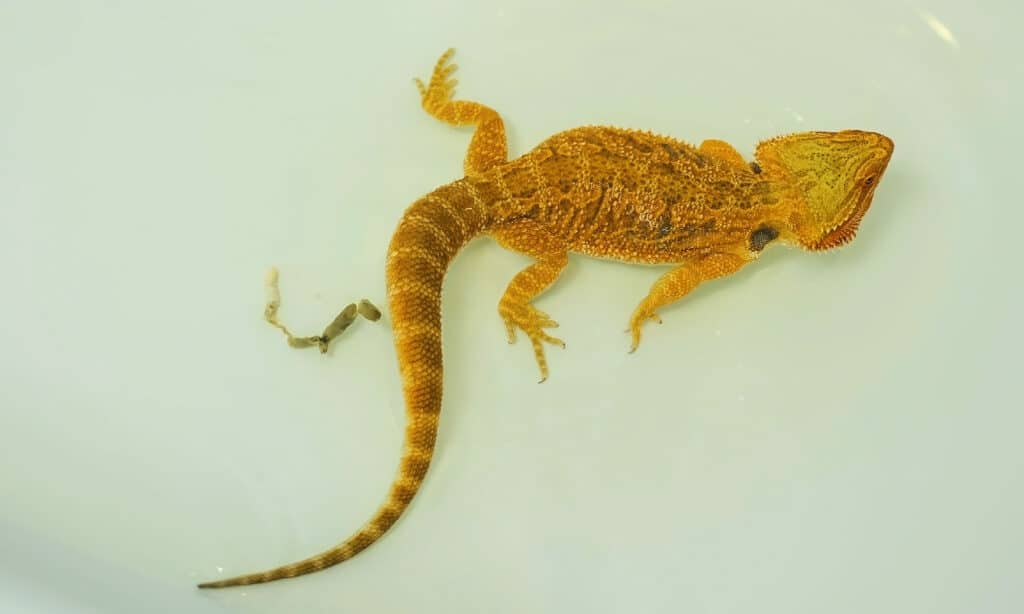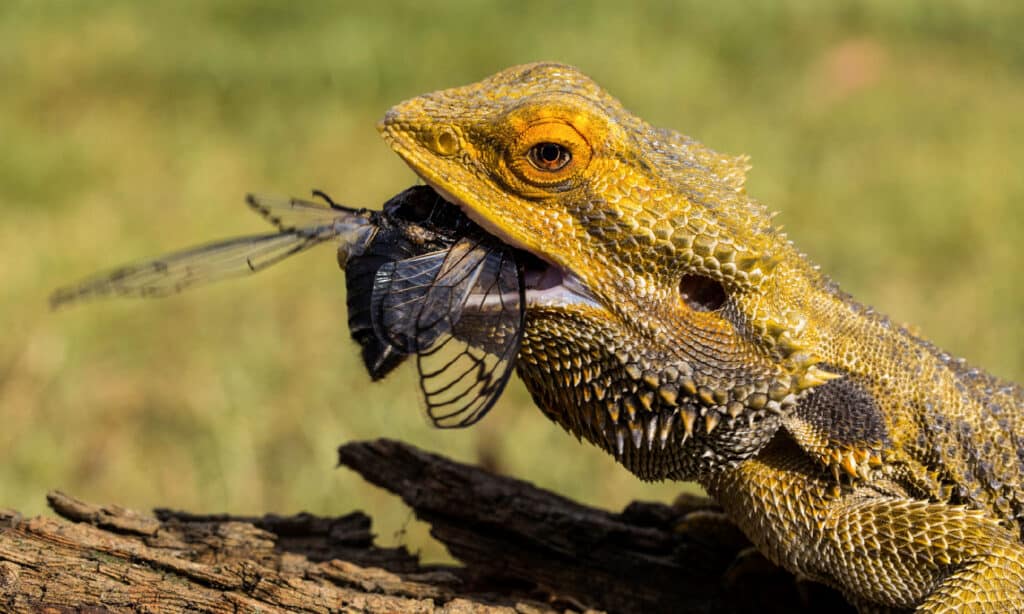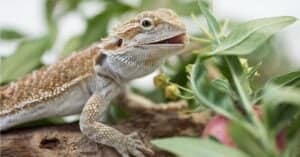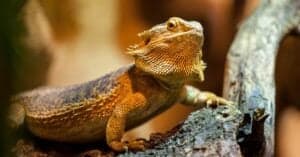The bearded dragon is native to Australia and is considered one of the world’s most friendly animals, making it a great pet option for many people worldwide. Aside from its beard, which helps identify the reptile’s mood, a host of other things can be deciphered by observing its poop. This article tells you everything you need to know about bearded dragon poop.
What Does Bearded Dragon Poop Look Like?

Bearded dragon poop is usually brown with white or yellow urates.
©Evgeniia Zakharishcheva/Shutterstock.com
Healthy bearded dragon poop would be brown and firm with white or yellow urates. The poop will also have a strong consistency and a log-like shape. The white part is the urate which is usually soft and does not smell.
What Do Different Kinds Of Bearded Dragon Poop Mean?
There are seven different types of bearded dragon poop, and each one has a way of informing one about the bearded dragon. Below is an elaboration of each poop type and what it means.
Brown Poop
The brown poop is the regular bearded dragon poop, indicating a healthy bearded dragon. When you see this kind of poop, you have no cause for alarm.
Runny Poop
Runny poop is usually a sign that your bearded dragon is suffering from diarrhea. The most likely reasons for this could be diet changes, parasites, or a bad diet. If you recently changed your bearded dragon’s diet, the runny poop will take some time before it stops. If, however, the foods are high in water content, you might need to make some adjustments to reduce the amount of water it takes. Also, it could be that parasites have infected your beardie. The primary way this can happen is through the insects that they consume. To be sure if it’s a parasitic infection, check if your bearded dragon is experiencing any of the following symptoms: mucus in stool, weight loss, lethargy, loss of appetite, anorexia, or foul-smelling poop.
White Poop
If the color of your beardie’s poop is chalky white, then you have a case of mild dehydration in your hands. Another symptom to check out for is string-like saliva. To get rid of this condition, your beardie needs short fifteen-minute baths, which can help rehydrate its skin. A repetition of this white poop even after care is a sign to visit the vet.
Bloody Poop
There are times when your beardie may be suffering from internal bleeding. Some sharp part of something it has eaten could have pierced its intestine and resulted in internal bleeding. If you discover a blood-like substance in your beardie’s poop, it’s something to be concerned about. If it becomes repetitive, then you sure need to see a vet.
Yellow Poop
If your beloved reptile is excreting yellow poop, it’s a sign they have excess calcium in their system, and this can lead to organ damage, particularly liver failure. It’s advisable to regulate the amount of calcium your bearded dragon is ingesting. A way to control the amount of calcium your bearded dragon gets into its body is by limiting the amount of Vitamin D that it gets from UVB lighting.
It’s noteworthy that there are yellow substances that aren’t poop but are excreted by male and female bearded dragons. In the female, it would be a case of infertile eggs being excreted. For the male, it would be a seminal plug that is often tinted yellow and string-like. A gentle bath and a massage can handle the issue for both sexes.
Black Poop
Black poop might indicate that your bearded dragon is consuming a lot of insects and little or no plant. This should be balanced by providing the necessary plant for the beardie’s diet. If, after doing this, you still see black poop, then you need to take the poop for examination. It could be possible that your beardie is suffering from inaction (block bowel movements), which can lead to severe constipation, tears, and internal bleeding. If the poop is smelly, it might signify a parasitic infection. It’s also worth mentioning that bearded dragon poop will darken as it dries up.
Green Poop
The bearded dragon consumes a lot of vegetables, which could sometimes leave a green-like pigment in its poop. It’s not a cause for alarm, especially if your beardie is acting all good. However, if your beardie is not feeling too good, it’s worth checking out. If the poop is green, runny, and smelly, it could point to severe conditions like liver disease, anorexia, and hemolytic anemia. If you suspect this is the case, then contact a vet.
What Do Bearded Dragons Eat?

As omnivores, bearded dragons depend on plants and animals for survival.
©iStock.com/Ken Griffiths
Bearded dragons are omnivores who depend on plants and animals for survival, although a higher percentage of their diet (around 73 to 76 percent) is plant-based. You can find a beardie eating vegetables and fruits like pepper, banana, sweet potato, and kale. They can also consume insects like crickets, cockroaches, locusts, mealworms, and kingworms.
Is Bearded Dragon Poop Dangerous?

The poop of a bearded dragon contains Salmonella, which can be very harmful to humans.
©iStock.com/huettenhoelscher
While the bearded dragon may be friendly, its feces is not. Its feces contain Salmonella, which might not prove deadly to the reptile but can be very harmful to humans. So, a very healthy bearded dragon can pass diseases to humans. It’s essential to be careful when handling the reptile or cleaning out its poop. Contact with the reptile may not lead to an infection, but having it too close to sensitive parts of the body, like the mouth, can lead to an infection. It’s advisable to clean off the poop with hot water and soap and to thoroughly wash your hands with the same.
What Are the Signs My Lizard May Have Parasites?
As was mentioned earlier, one factor that can affect a bearded dragon’s poop is being infected with parasites. Bearded dragons can contract intestinal parasites through having contact with other infected reptiles, contact with contaminated surfaces or objects, or by consuming infected food. Also, a bearded dragon captured in the wild can already carry an infection.
Different types of parasites a reptile can become infected with include roundworms, hookworms, or pinworms. Of the three, roundworms are the most common. The worms could show up in the feces or even vomit, but even if they are not apparent, your lizard could still have them. Signs your bearded dragon may be infected include appetite loss, weight loss, abnormal stools, diarrhea, or vomiting.
If your bearded dragon is displaying one or more of these symptoms, it’s important to get it seen by a veterinarian who treats exotic animals, because if parasites are left unchecked, they can lead to severe illness or even death.
The photo featured at the top of this post is © Ken Griffiths/Shutterstock.com
Thank you for reading! Have some feedback for us? Contact the AZ Animals editorial team.







